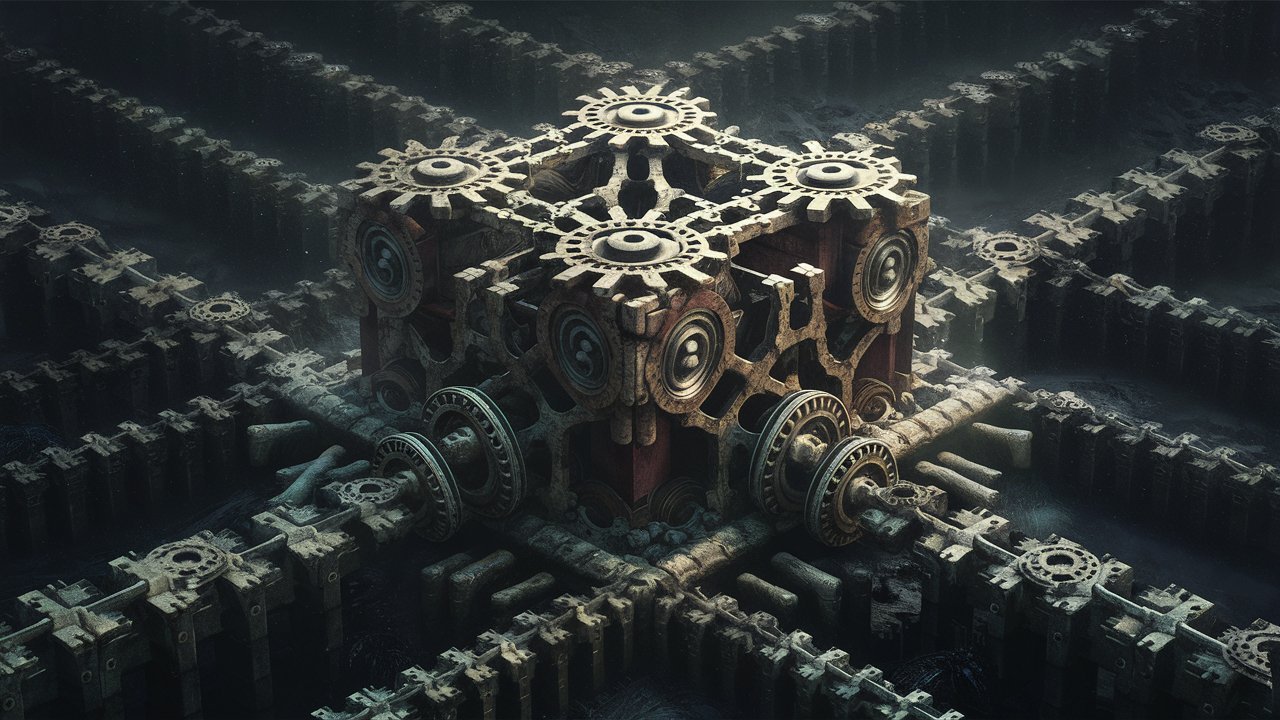The behavior of everything at every scale in the Novel Universe Model results from a trivalent reaction (yum, yuck, meh) between conscious actors (panpsychism). For example, on the human level, this is as simple as walking past someone, and either stopping to talk (yum), hurrying by (yuck), or not noticing them at all (meh). This fundamental paradigm, we call “Quantum Transience,” underlies every interaction, from quantum particles, to biological processes, to people, planets, galaxies … everything.
Quantum Transience is a non-local, information-sharing process based on an embedded, cryptic cellular automata matrix – bones concealed inside flesh. Cellular automata are metaphorically like rows of boxes. In our metaphor, some of these boxes are empty, while others have a toy inside, say, a little “body” with a detachable, special-colored “head.” The body is what NUM labels a Node Point Communicator (NPC), the head, a Signature-Frequency Set, and the head’s color, the Set’s unique personality. Quantum Transience is the swapping of heads between toy bodies, allowing for the direct transmission of non-local information. The QT Gradient is the heads’ reaction to each other’s personality – qualia. This reaction results in a trivalent transition of the toy body between boxes (along with its current head) – yum, closer; yuck, farther; meh, no change.
For example, let’s say we have four of these boxes in a row. Initially, the inside of each box is temporarily colored like its occupying head, while the outside temporarily colors the toy’s body. In order, the boxes have the inside colors: blue, black, red, and white; and outside colors: yellow, tan, green, and gray, respectively. Let’s say a blue head on a yellow body and a red head on a green body decide to swap. As the swap occurs, the red head is detached from the green toy body, removed from its green-red box, and placed on the yellow toy body in the yellow-blue box, with the blue head doing the same, only in reverse, landing in the green-red box on the green body.
Once the swap occurs, each head independently reacts to their new environment: do they like the box’s interior, dislike it, or ignore it? Based on their reaction, three things happen: movement, learning, and occupation. We’ll say the red head likes the blue hue. First, movement. The yellow toy body with the red head moves from the blue-yellow box into the black-tan box – the box closer to the blue head. Think of this like moving closer to talk with that friend instead of passing them by in silence. Second, learning. Because the red head likes the blue, it adds the color to its personality, turning purple. And last, occupation. The former red head’s newly occupied black box changes its internal color to reflect the purple hue of its head, while its toy body takes on the box’s external tan color. To sum up, we started with a red head on a green body in the third box, and ended with a purple head on a tan body in the second box.
For contrast, the blue head does not like the red, and moves its toy body in the opposite direction, away from the former red head, into the white box, with its body turning gray. Think of this as hurrying past a foe, and donning noise-canceling headphones designed to block that person’s specific voice. Instead of incorporating the red, the blue head suppresses the red by adding a phase-shifted light frequency that will obliterate the red color should they again swap. Now, if both had been neutral to their post-swap environment, their toy bodies would remain in their current boxes with their current color, and the colors of their heads would also remain unchanged. The only difference would be that the inside colors of the boxes would flip – the sequence of boxes no longer blue, black, red, and white, but now, red, black, blue, and white. Quantum Transience how the swapping of toy heads causes the toy bodies to move to other boxes, either closer to or farther from their paired participant. Additionally, the trivalent QT Gradient (incorporate, inhibit, neutral) generates a change in the head’s color (learning), for instance, red to purple, based on the red head’s reaction to the blue head’s personality.
How does the actual mechanism behind this non-local effect work? It’s not so much a movement of those heads, as it is a manifestation of their unique pattern in one place or the other. In the NU Model, everything is data, and the movement of this data from one toy body to the other would be akin to the “transmission” of two notes between two guitars. These notes do not physically move from one instrument to the other, but instead, those guitars might “swap” the notes they’re playing between each other. This coordinated change in pitch between instruments is the “transmission” of those notes across space – the mechanism of non-local information transition along the cellular automata “thread.” Those NPCs are like those coordinated guitars, while their swapping notes, Signature-Frequency Sets.
The thread of cellular automata cells, or row of colored boxes in our metaphor, is like the guitar’s string. The note being played corresponds to the fret on which the finger presses – the box in which the body resides. When the note being played changes frequency, the finger simultaneously changes frets. In a sense, the formally red head’s toy body changes its color from green to tan, which causes the body to disappear from green box, and manifest in the tan. This is also true for the blue head swapping bodies, as if the blue head’s “neck” changed from yellow to green.
As with the Pauli exclusion principle, no two guitars can play the same, exact note simultaneously, and like the superposition of electron entanglement, which instrument is actually playing which of the pair of notes is only known when observed, but once observed, the other note is necessarily implied. At the most fundamental level of the Novel Universe Model – the cellular automata matrix – information doesn’t move so much as manifests from one point in space to another, the way a knot might “move” along a string by simply being tied in one spot, and then retied in another spot. It doesn’t require some external force to move the knot, only information – where to next tie the knot.
This trivalent reaction is seen at every level of complexity – what human emotion or quantum effect cannot be roughly described as either yum, yuck, or meh? Instead of the universe as a probability map, it’s a messy conversation, happening between peers and levels of complexity. The QT model allows for both agency and influence, based on the independent expression of preference. Option space is bent, not through force, but through valance – those desired options are made more yum, while those to be avoided, more yuck. QT models quantum effects, not as randomness, but the expressed intention of cognitive actors, based on their preferences and freewill – two foundational tenets of the religion.
The NU Model’s cellular automata matrix is called the Hypergraph, which is embedded (hidden) inside the Hypersphere. The Hypergraph’s cells are the colored boxes of our metaphor. The Hypersphere is the physical space of the universe, made of “atoms of space” called Nodes – the spatial “pixels” of the universe. The relationship between the two matrices is like bones (Hypergraph) inside a body (Hypersphere). As the Hypergraph underlies the Hypersphere, its effects are cryptic, accumulating within in the microscopic, internal world of Lower-Order Bodies and their unobservable black boxes, not directly within the macroscopic, external world of Higher-Order Conductors and their observable models of assembled behavior. The Hypergraph functions like the mind of matter that influences, rather than the body that animates. Quantum fields and waves are shaped by the NPCs, the way those toys’ bodies move through those boxes based on the heads’ interactions. NPCs, themselves, are not physical particles, but instead, spatial, informational points where interactions occur, say the multi-pixel space of an electron field interacting with a photon wave. The interaction of these waves and fields assemble into quantum particles, that assemble into atomic particles, that assemble into molecular particles, that assemble into … the universe of energy and matter.
Read our philosophy and Creed to better understand our TOE

